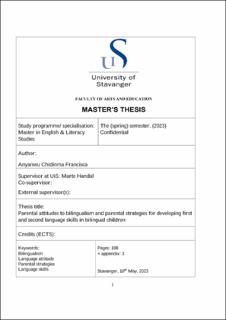| dc.description.abstract | Much research has been carried out concerning parental attitudes and strategies towards bilingualism. However, fewer studies have concentrated on kindergarten and elementary-level children and involved parents from different language backgrounds, focusing on all four speaking, listening, reading, and writing skills. The current study is focused on the involvement of parents in the home in order to develop the English language as the second and focus language, in addition to the mother tongue, within the Norwegian language environment. In other words, this study explores if parents encourage the application of bilingualism in speaking, listening, reading, and writing activities in the home environment. Importantly, this project is bed rocked on the mindset of parents, either positive or negative, toward bilingualism. In this study, the participants were bilingual families who live and work in the Stavanger and Sandnes areas of Norway, with children between three to six and six to nine in Norwegian kindergarten and elementary schools. To achieve the objective of this study, a qualitative research method was chosen for data collection. Amidst the qualitative data collection approach, the researcher adopted a semi-structured interview, where eight families volunteered to participate in the study. This study would guide parents raising bilingual children living in a country other than their own on the strategies they could use for different language skills at home.
The study's main findings were that all the interviewees, especially mothers, were much involved in reading comprehension and writing with their children and motivated them by buying or borrowing books. As for the speaking skill, all families had dinner-time discussions, in which parents and their children unofficially talked and listened to one another about personal and family matters. Among other speaking activities, dinner-time discussion had been favoured. In addition, the participants submitted that their children liked watching TV, listening to songs and stories from YouTube/audio-visual appliances, and their parents, respectively. The interviewees had strong positive attitudes toward bilingualism and wanted to raise bilingual children, at least with a focus on their mother tongue and English. They believed bilingualism would add substantial cognitive, educational, social, emotional, behavioural, and cultural benefits to their children; thus, they applied different domestic strategies to support the language skill development of their children in speaking, reading, listening, and writing. The participants also employed similar correction strategies in all the involved language skills, though with slight disparity according to family background and parental job schedules. Furthermore, all the participants wished their children could maintain English and their mother tongue simultaneously, including the language of the environment, but not all the participants put in the effort to keep or maintain the two languages regarding the four language skills, especially the ones with children between three to six. Additionally, the following chapters will present detailed information and discussions about the findings through the semi-structured interviews with the participants. | |
